Palenque used to be one of the wealthiest and most powerful Mayan city-states in Pre-Columbian Mexico. It was founded in the 3rd century CE and it reached its peak in the period from 500 to 700 CE. Today, this is a famous archaeological site situated on the slopes of the Chiapas mountains not far from a contemporary city after which it has been named. Following its peak, when it was the regional centre, the construction of large stone structures in Palenque ceased and by the 10th century the settlement was abandoned, after which over time it got completely covered by the rain forest and it remained like that until it was discovered in 1740.
During my visit to the site, once I passed by and took photos of a couple of structures a visitor comes across first, I climbed the west stairway of the Palace in order to have a better view from there of the Temple of the Inscriptions.
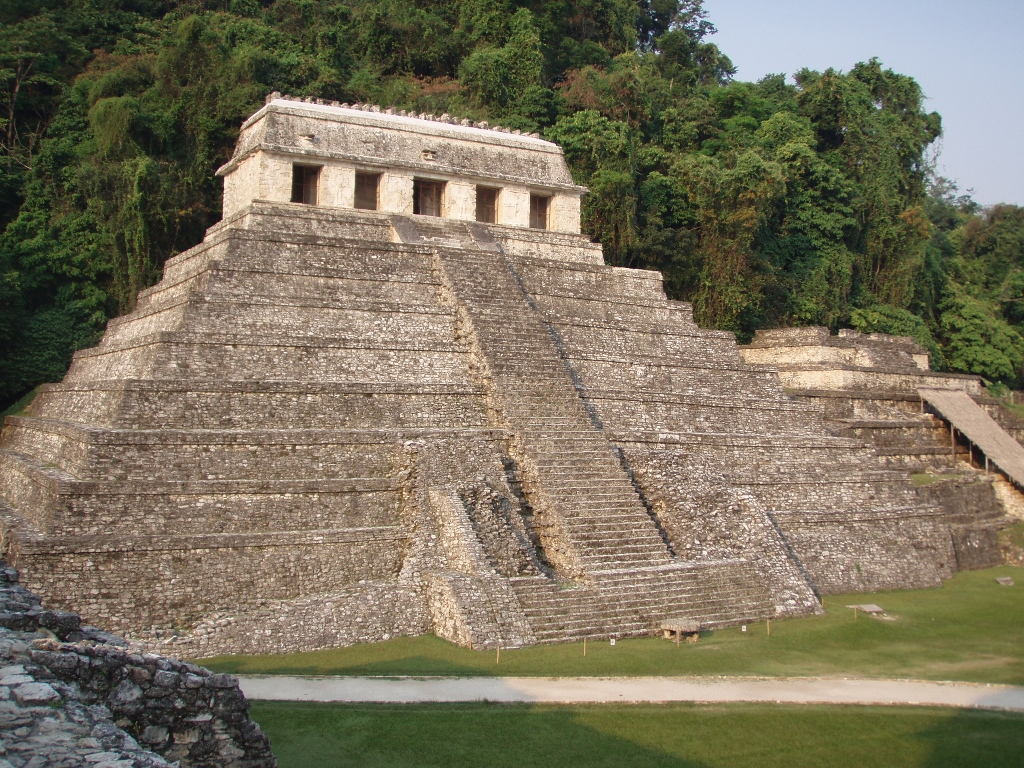 Temple of the Inscriptions
Temple of the Inscriptions
This is a stepped pyramid which is also the tallest structure within the site. It is 60 m wide (when looking from the front side), 42.5 m deep and around 27 metres high. It was built during the reign of king Pakal (615-683 CD); or more accurately, its construction started in 675 CE. When you get to the temple that is located at the very top of the pyramid, the climbing being prohibited today, on the walls of the halls there are 617 carved glyphs and this explains the name of the temple. This is the second longest text written in the ancient Mayan glyphs (the longest one is in Copán, Honduras which I visited some dozen days later). I could also add that on the basis of the remains of colour, the scientists have concluded that the temple used to be painted in vivid red, with yellow and blue details. When it looks this magnificent today, who knows how impressive it must have looked like in its original form.
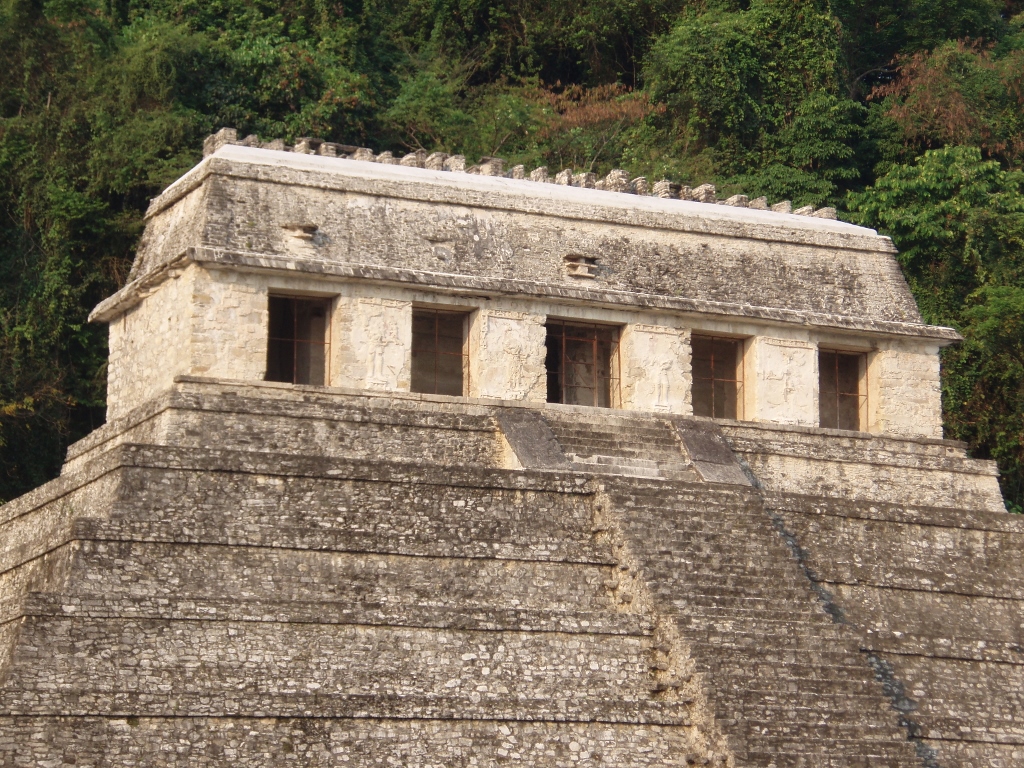 Temple of the Inscriptions
Temple of the Inscriptions
And then, in 1949, archaeologist Alberto Ruz Lhuillier who at the time led the works at the site, found in the floor of the temple, under a stone slab, a stairway that was completely filled with rubble. It took three years to clear up the stairway and then, in 1952, 25 metres below, the archaeologists came across a tomb and a sarcophagus in which they found remains of King Pakal, whose full name was Kʼinich Janaab Pakal I or Pakal the Great. At the time it was the best preserved and the richest tomb ever found in Americas. Later (in 1987) the tomb of the Lord of Sipán was discovered, but I have already written about it (https://www.svudapodji.com/en/lima-and-north-peru-peru-and-bolivia-summer-of-2005-part-2/).
The tomb is 9 m long, 4 m wide, while the height of the vault is 7 m. The walls are adorned by dynastic ancestors done in the stucco technique, while the lid of the sarcophagus is carved magnificently. But, not only is it no longer permitted to climb to the top of the pyramid, it is also not possible to get down to the tomb, since it has been sealed. Still, the original death mask of king Pakal I made of jade and all of the movable accessories, as well as an excellent reconstruction of the entire tomb may be seen in that spectacular National Museum of Anthropology in Mexico City which I mentioned the last time.
Although I admired the Temple of the Inscriptions from the stairway of the Palace which I had climbed, I decided to descend and go around first and to leave the visit of the Palace for a little while later. Still, before doing this, I took a photo of its tower.
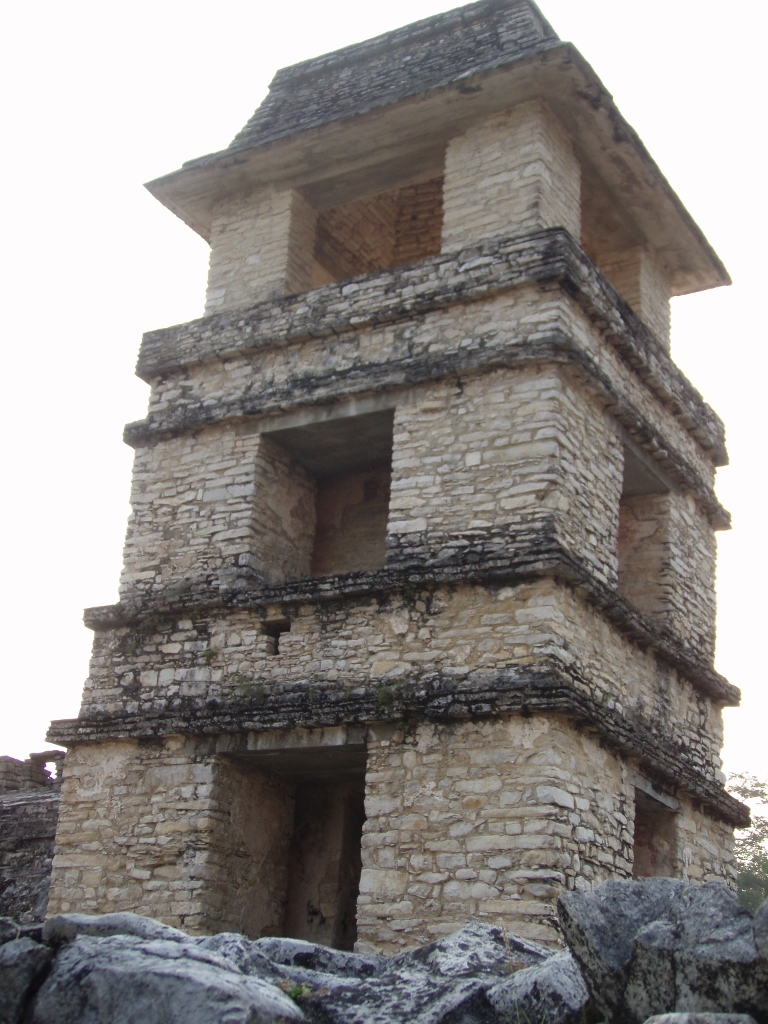 Tower of the Palace in Palenque
Tower of the Palace in Palenque
On the basis of the information on the site I had with me in the shape of a couple of photocopied pages from a guidebook on Mexico, I realised that the next interesting structure I could visit was the Temple of the Jaguar (Templo del Jaguar). The temple got its name because of a bas-relief that depicts a king sitting on a jaguar-shaped throne. The information also said that the temple had not been fully cleared yet and that it was to a large degree covered in vegetation. This was apparently a good thing since on the basis of that it could be concluded what this all used to look like before the research and the restoration done by experts. When I got to some ruins following a path, I concluded that this must be the temple I had read about, since the structure was in a rather crumbly state. Nowadays I’m not sure that I got to the temple and these may have been the remains of another, significantly less important structure, but the point is that at the time I did not feel like proceeding any further, for it all looked brittle.
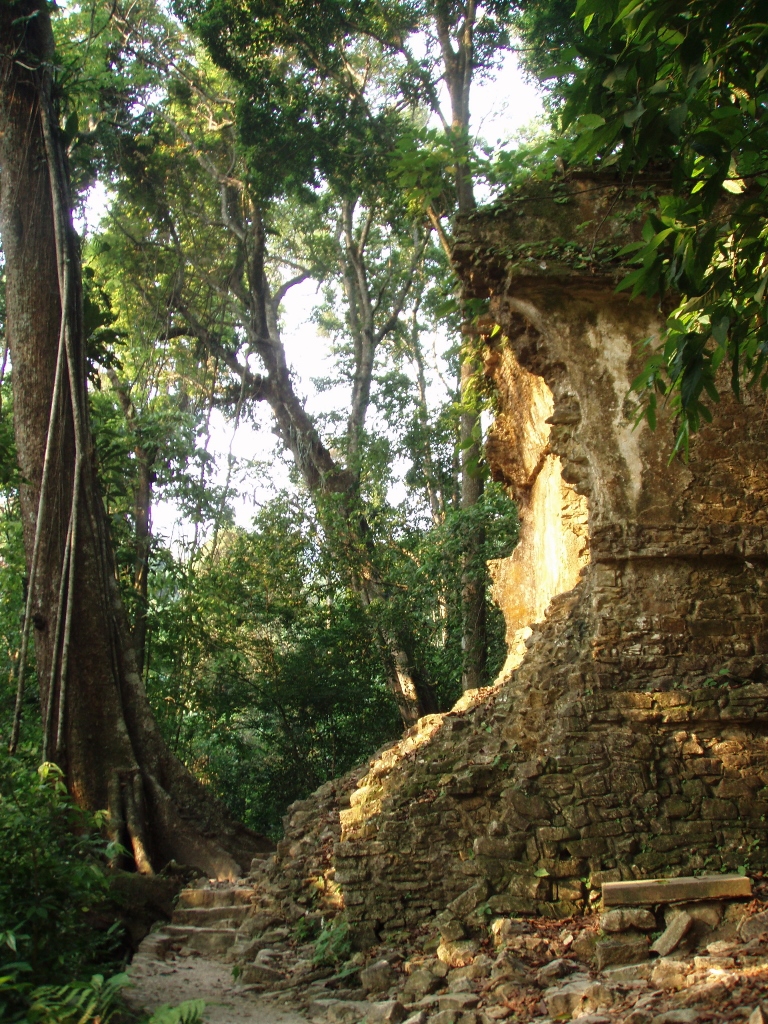 Ruins in the jungle
Ruins in the jungle
However, what was particularly beautiful in this place was that I was completely alone and, apart from the sounds coming from birds, there was perfect peace around me. But, even that was not all. Look again at the tree on the left-hand side of the above photo with practically no reference object and now look at the same tree with me as a reference object (I’m 1.8 m tall). Only now can it be seen how huge the tree is.
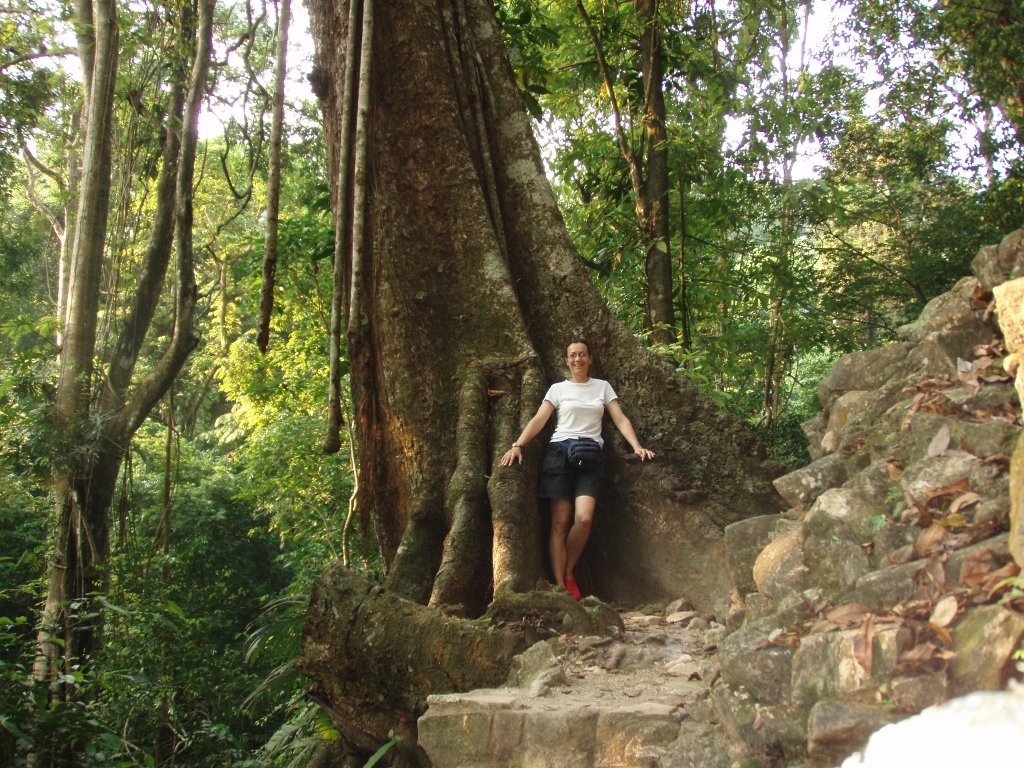 Cradled by a stunning tree
Cradled by a stunning tree
It was right around here that my love affair with the huge trees of Central America started. I don’t know which tree species this was, but almost every time when I think of trees, forests and greenery, I remember precisely this moment and this place, and I see myself cradled by this beautiful, magnificent tree.
After enjoying in the company of trees for a short while, I went back along the same path to the central section of the archaeological site of Palenque. In order to move on, following the visitors’ path, I had to go over a small bridge, since there is a man-made water canal running through the site.
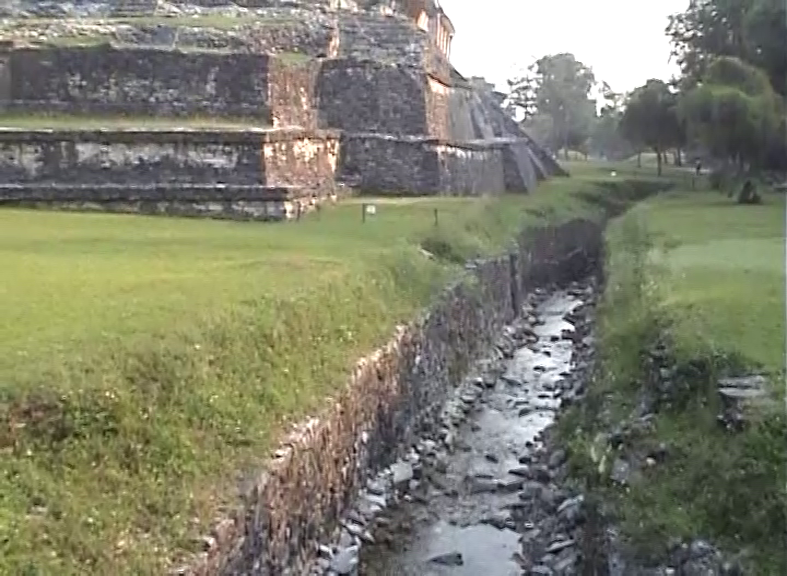 Water canal
Water canal
All around Palenque, there are a lot of waterways and the old name for this Mayan city, Lakamha, means Big Water.
From that small bridge I had again a very nice view at the Palace in Palenque.
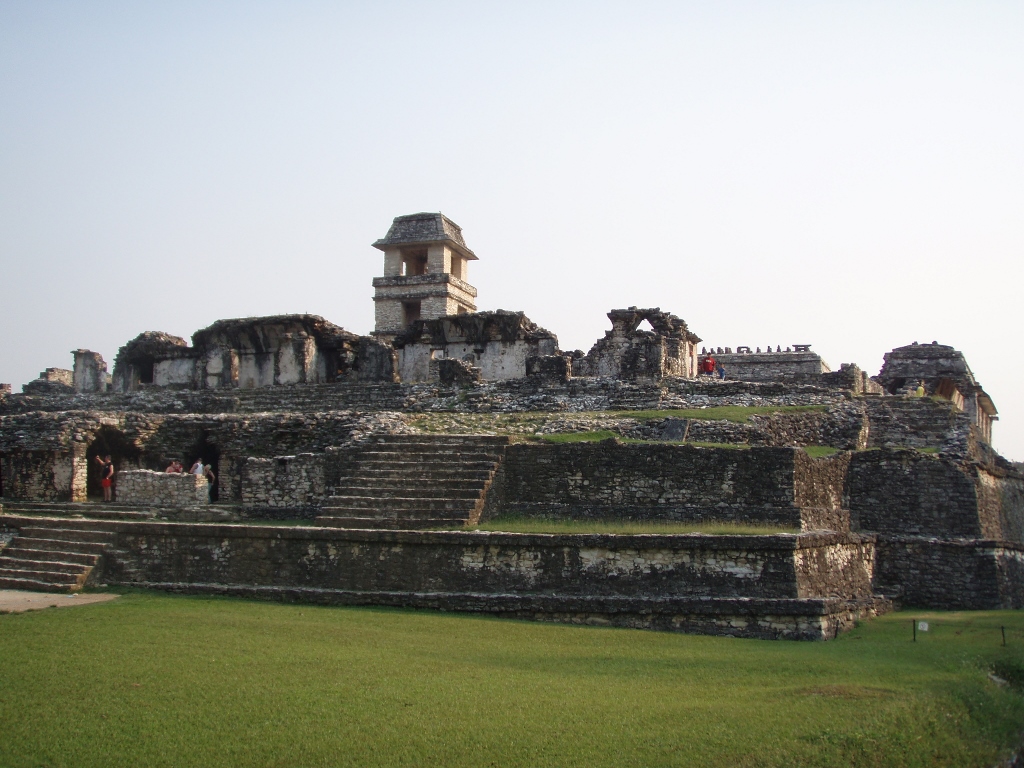 The Palace in Palenque – south view
The Palace in Palenque – south view
Although it was still early, alongside the visitors’ path, before and after the bridge, there were numerous local souvenir vendors who ware arranging their goods on the canvasses laid down on the ground.
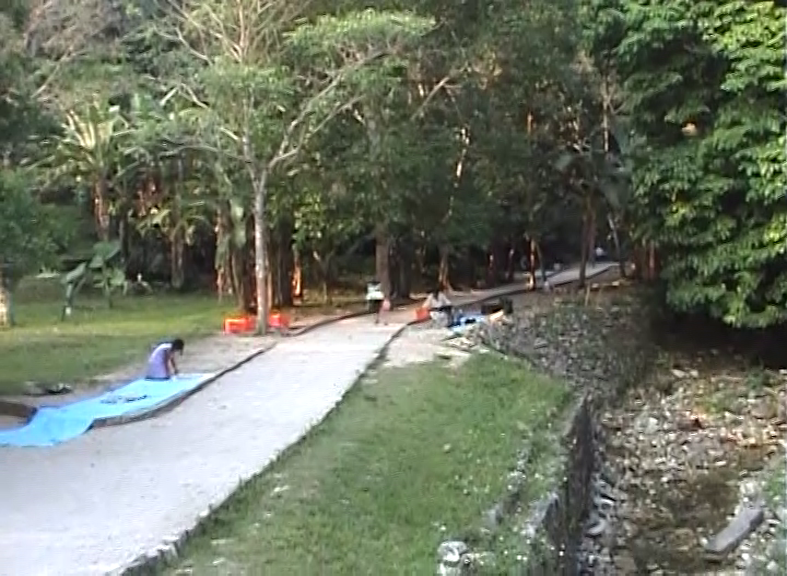 Getting ready to sell souvenirs to visitors (the water canal is to the right)
Getting ready to sell souvenirs to visitors (the water canal is to the right)
By the way, here too, I had an impression that everybody worked – the adults, as well as children. It is clear to me that the local population is, on an average, on the short side, especially in comparison to me, which may be misleading, but I still had an impression that some of those vendors were not even teenagers.
In any case, I continued with my sightseeing and so I got to an important group of structures called the Cross Group or Complex. This group consists of three main and two smaller temples that are situated around an open square.
First from the square I ascended the Temple of the Sun (Templo del Sol). It is one of the best preserved structures in Palenque. The temple is situated on the top of a step pyramid with four tiers and it can be reached by a wide stairway.
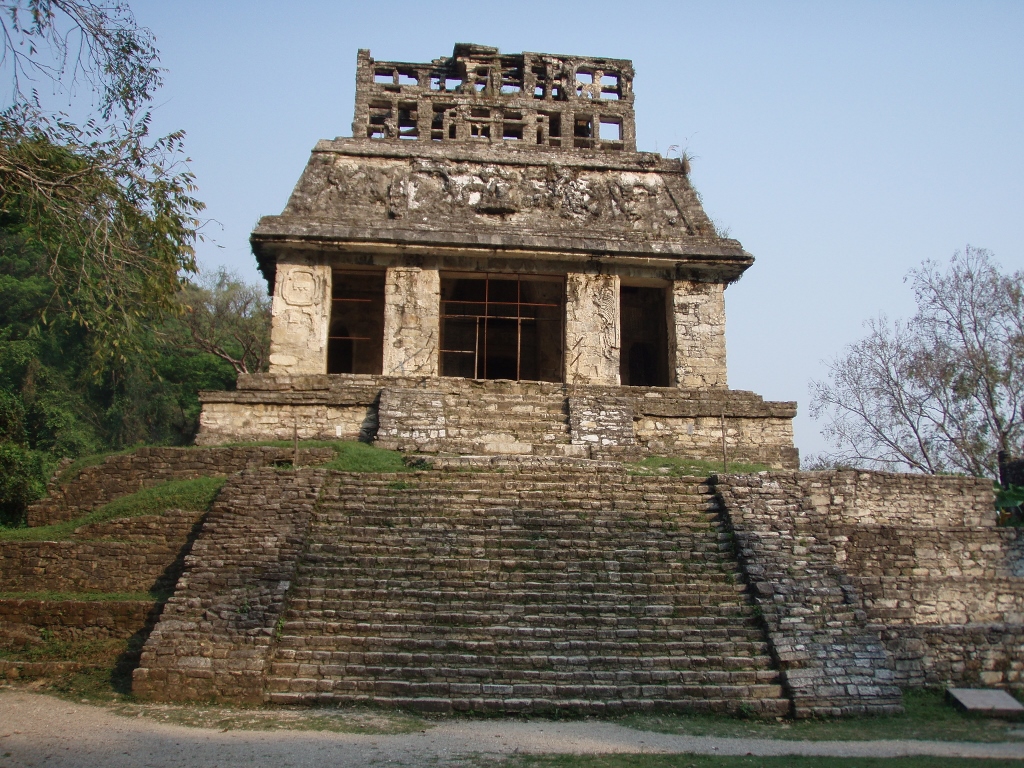 Temple of the Sun
Temple of the Sun
One of the important features of this temple is an impressive roof comb – a huge carved stone slab, while the pillars carrying the roof are decorated by applying the stucco technique.
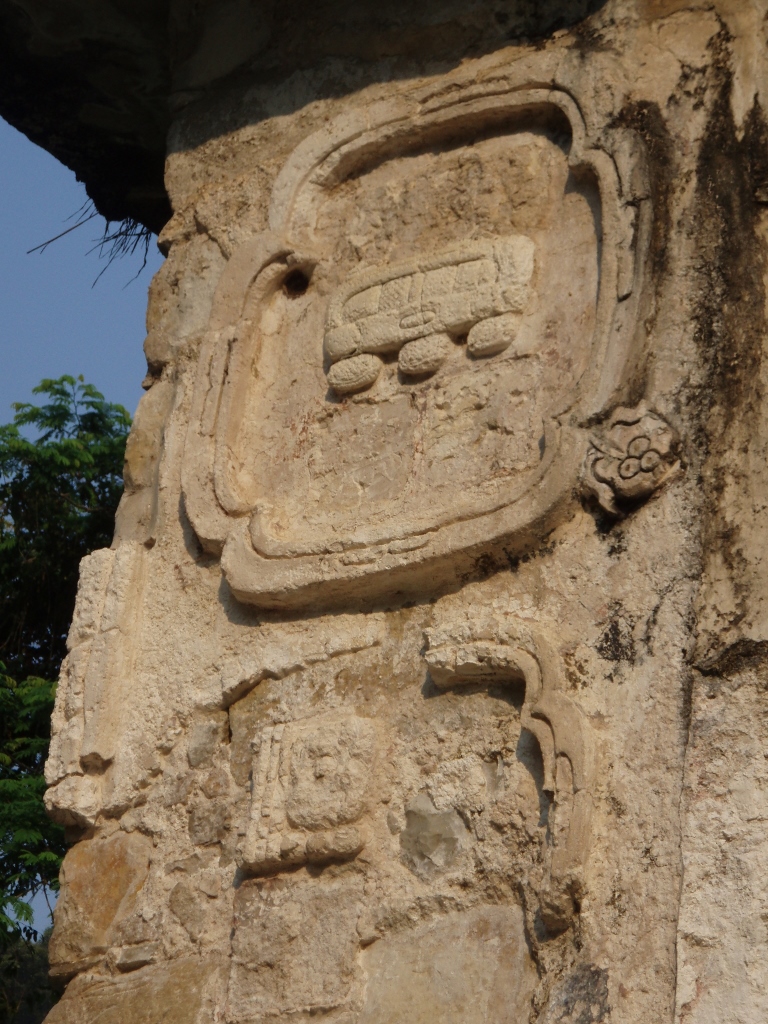 Temple of the Sun – a detail of the decoration on the pillar
Temple of the Sun – a detail of the decoration on the pillar
The reason why this temple is called the Temple of the Sun is that on the back wall of the shrine there is a depiction of the Sun carved in the middle of the stone panel.
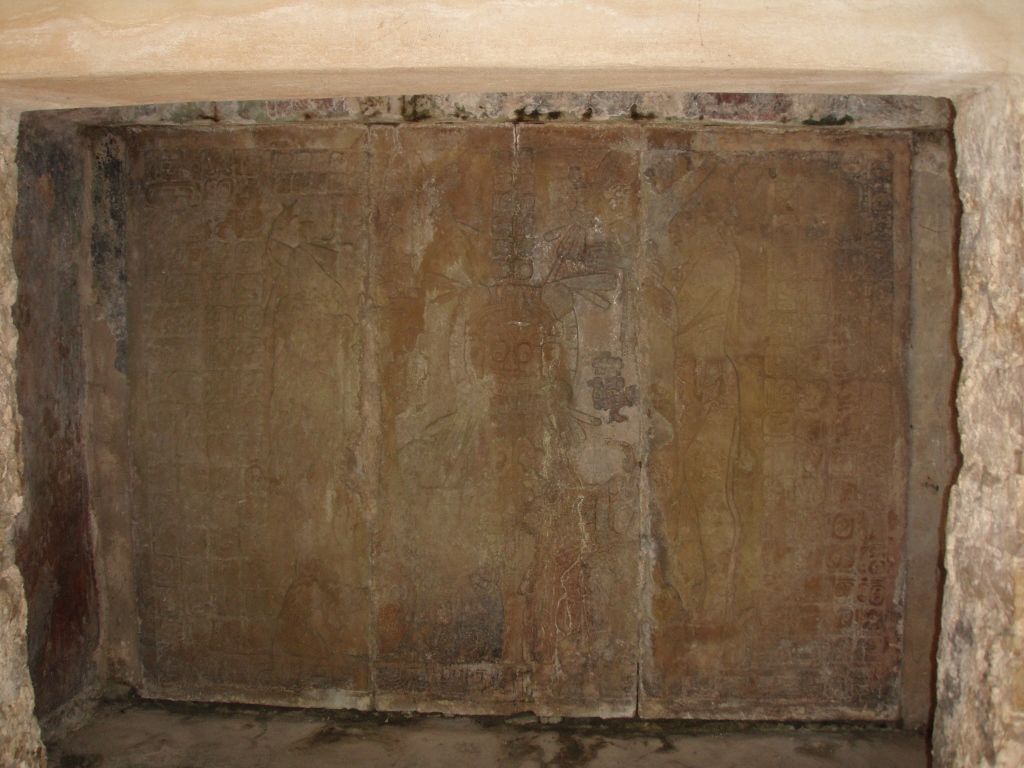 Temple of the Sun – back wall of the interior shrine in the temple
Temple of the Sun – back wall of the interior shrine in the temple
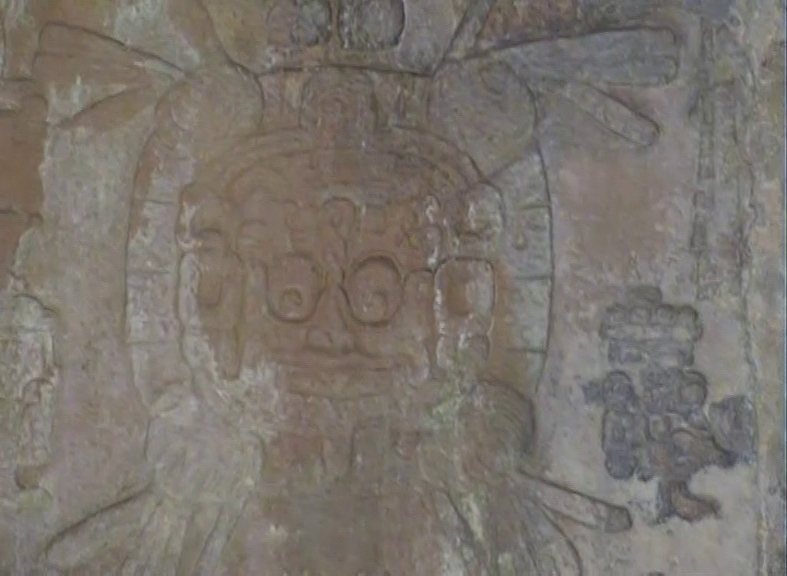 Temple of the Sun – the depiction of the Sun
Temple of the Sun – the depiction of the Sun
To the right and left from the central figure of the Sun there are depictions of the son of Pakal the Great whose name was Kʼinich Kan Bahlam II (ruled from 684 to 702 CE). By the way, these rulers held a king-type of title which was called the ajaw in the Maya civilisation. It is interesting that these two figures show king Kʼinich Kan Bahlam II when he passed the rite of passage at the age of 6 and when he ascended the throne at the age of 48.
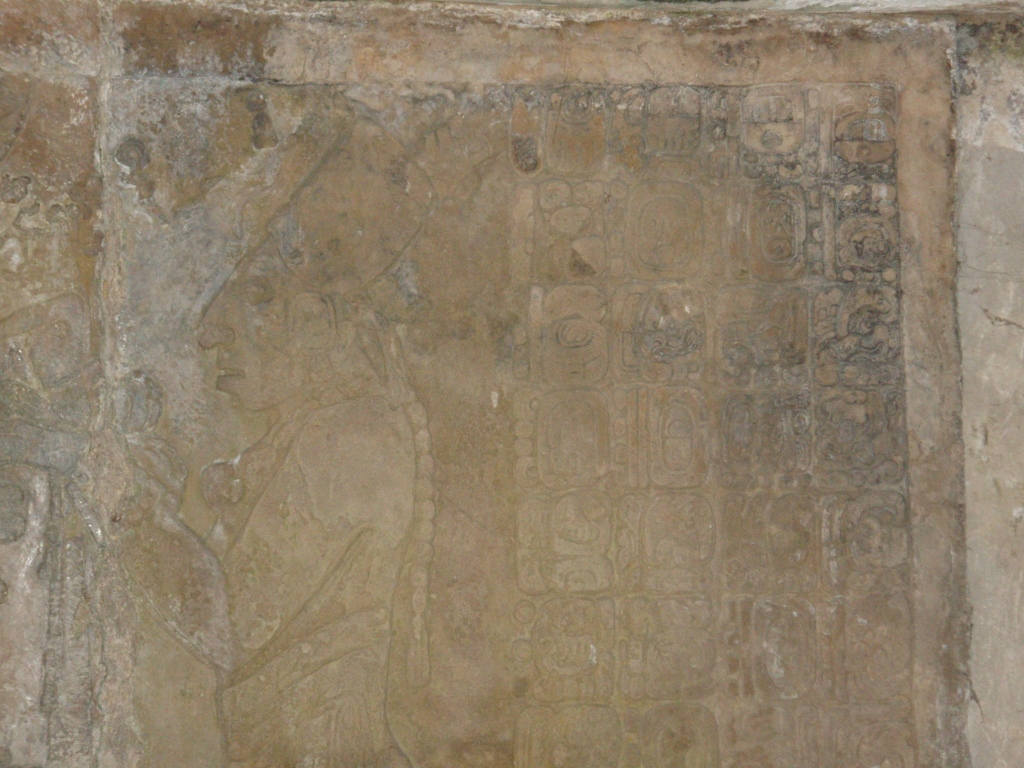 Temple of the Sun – depiction of king Kʼinich Kan Bahlam II when he ascended the throne at the age of 48
Temple of the Sun – depiction of king Kʼinich Kan Bahlam II when he ascended the throne at the age of 48
The relief shows a lot of Mayan glyphs which may also be seen nicely in the photo above.
When I got out in front of the Temple of the Sun I could see well from there outside the other two important temples within the Cross Group: the Temple of the Cross (Templo de la Cruz) and the Temple of the Foliated Cross (Templo de la Cruz Foliada).
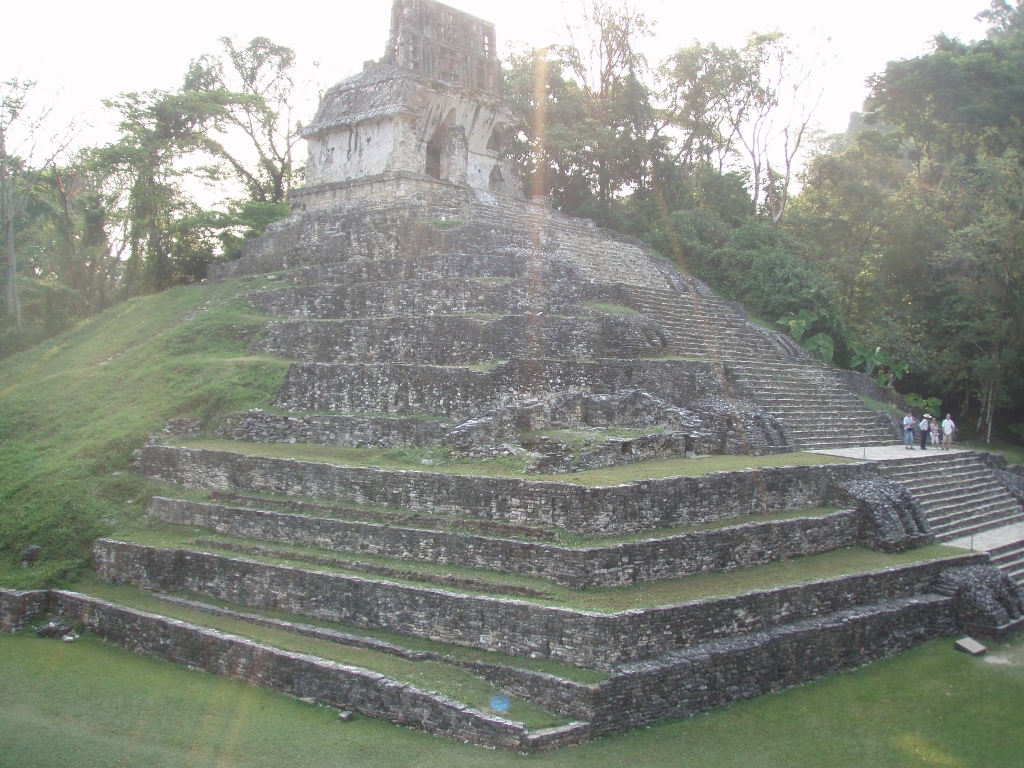 Temple of the Cross, left of the Temple of the Sun
Temple of the Cross, left of the Temple of the Sun
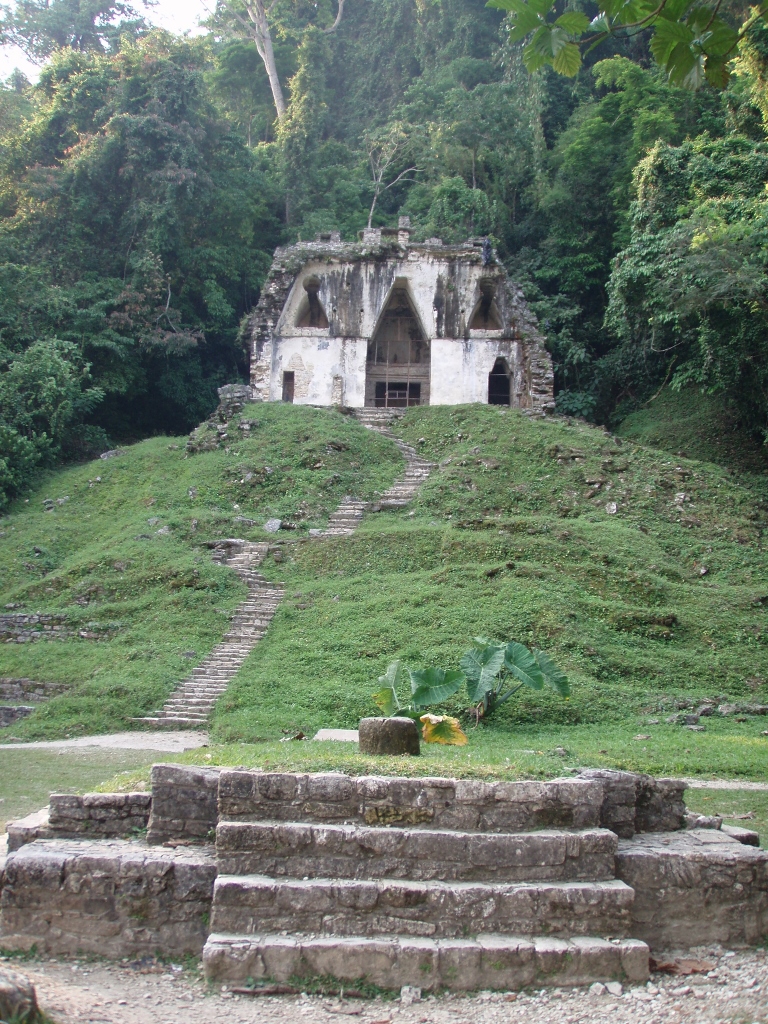 Temple of the Foliated Cross, directly across the Temple of the Sun
Temple of the Foliated Cross, directly across the Temple of the Sun
The Temple of the Foliated Cross has been named like this because of a panel that shows the maize plant in the shape of a cross. This is the smallest of the three important temples and the front part of its corbel vault has fallen off in the meantime.
First I started to climb the stairs leading to this temple, but when I saw how many stairs there were on the Temple of the Cross waiting for me to climb them, I stopped what I was doing and simply looked up towards the top of the elevation. No depiction of maize in any shape or form is that important to me.
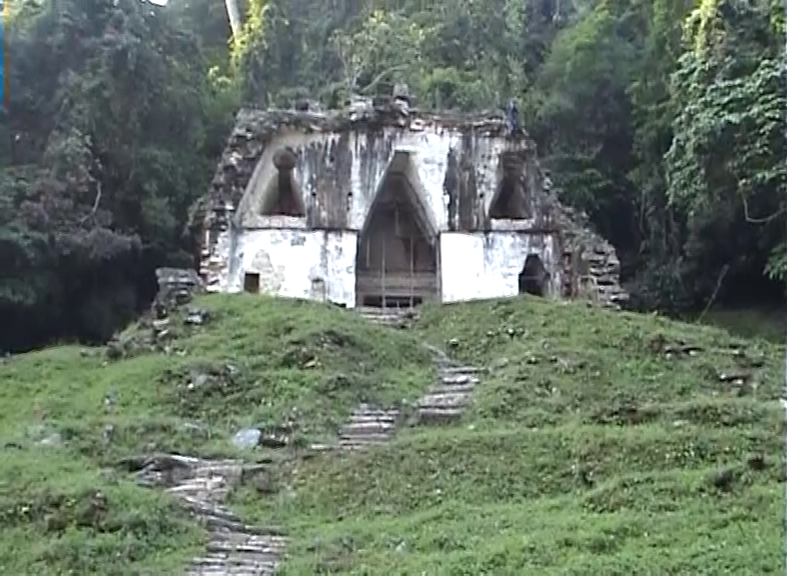 Temple of the Foliated Cross
Temple of the Foliated Cross
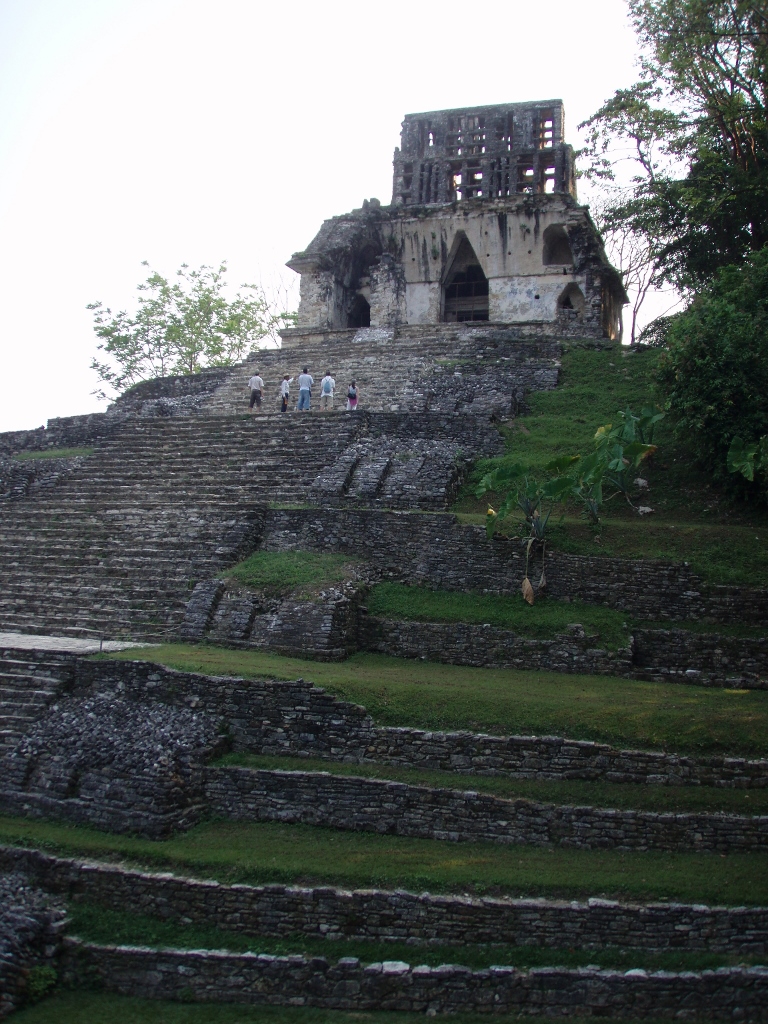 Stairway of the Temple of the Cross – I am yet to climb here
Stairway of the Temple of the Cross – I am yet to climb here
I also looked back and glanced once more at the square where now I could also see Temple XIV (Templo XIV). It used to be very much destroyed, but has been reconstructed over time.
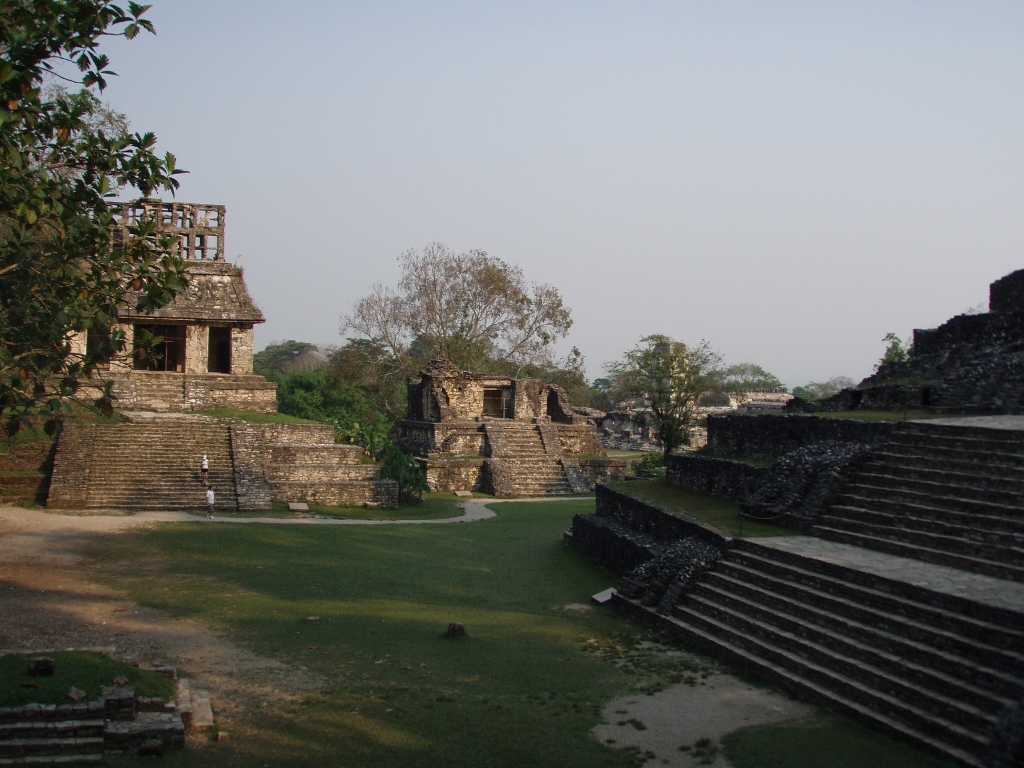 Square within the Cross Complex (from left to right): Temple of the Sun, Temple XIV, stairway of the Temple of the Cross
Square within the Cross Complex (from left to right): Temple of the Sun, Temple XIV, stairway of the Temple of the Cross
Before climbing to the top of the Temple of the Cross, I looked once again across the square at the Temple of the Sun.
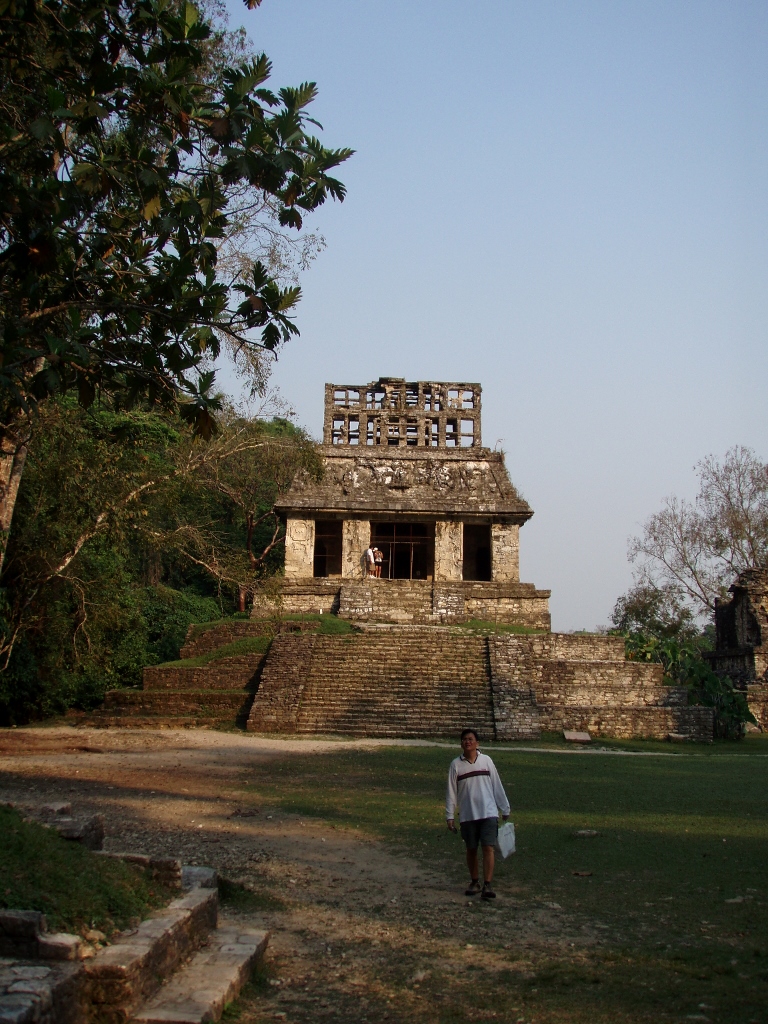 Temple of the Sun
Temple of the Sun
And then I started to climb. In fact, the climbing was not that difficult in the end, for I had a perfect “excuse” in front of myself for making frequent breaks on the “terraces” that exist on the stairway because of the very stepped nature of the pyramid which is topped by the temple.
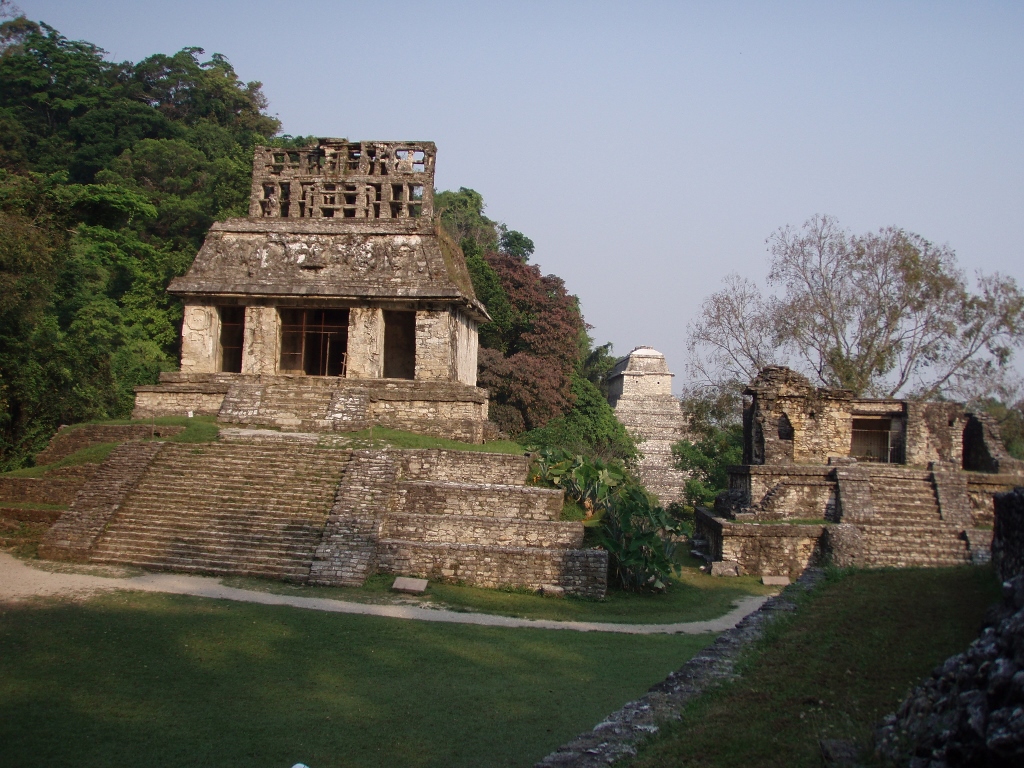 Temple of the Sun and Temple XIV
Temple of the Sun and Temple XIV
From one of these terraces there was a perfect view at the Palace, too.
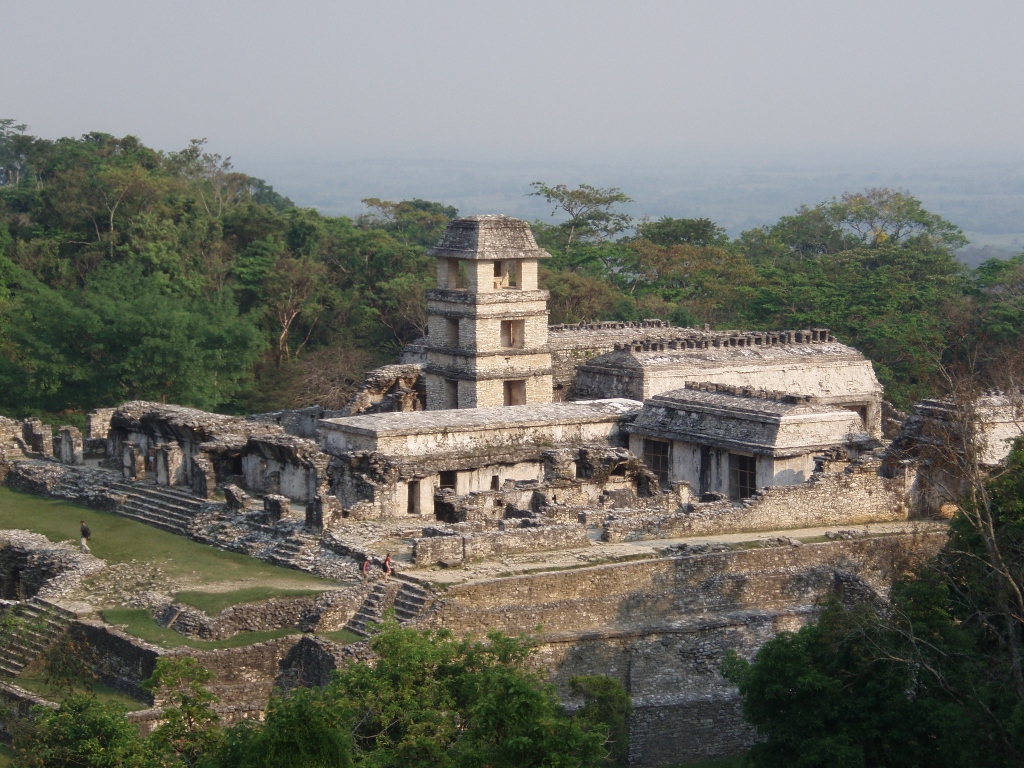 Palace in Palenque
Palace in Palenque
Although there were not too many visitors here, luckily there were enough of us that I could exchange the taking of photos with.
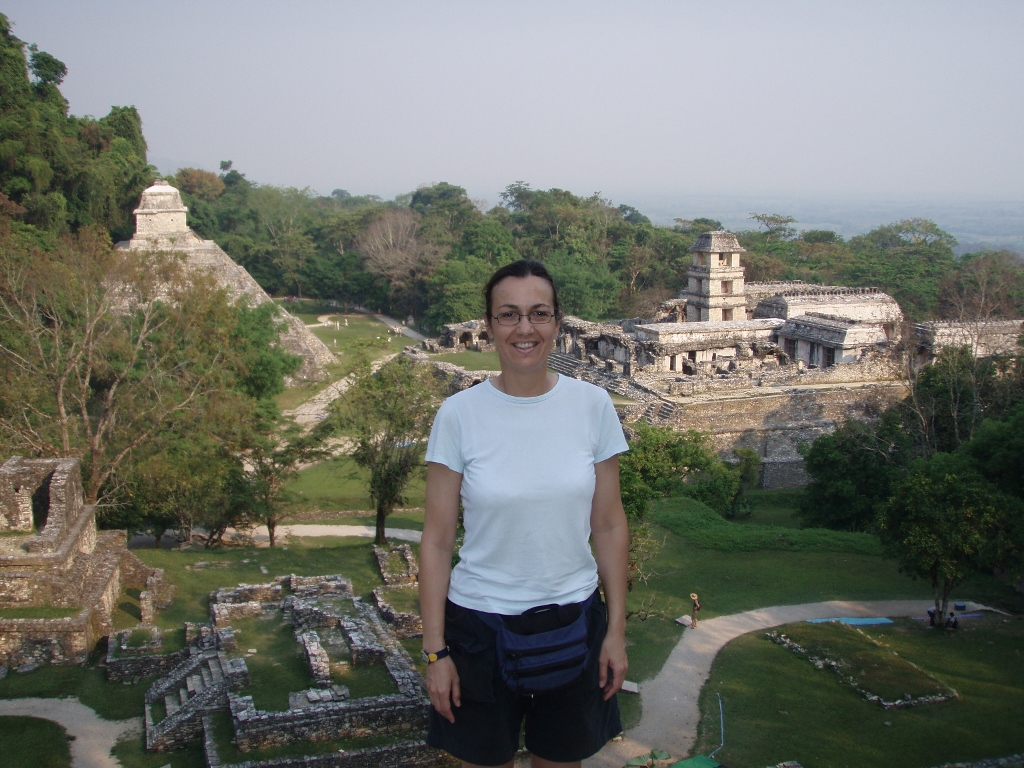 Wonderful memory from Palenque
Wonderful memory from Palenque
Right to the left from me, in the bottom, it is possible to see the remains of a very much destroyed Temple XV. In the upper part of the photograph, there is the Temple of the Inscriptions to the left and the Palace to the right.
As for the Temple of the Cross, this is the biggest temple in the Cross Group. It has been placed on the top of a five-tier step pyramid. As I approached the top of the pyramid and the temple itself, I could see nicely and from up close the roof comb which the ancient Mayas often used when decorating their structures. It is also possible to see the central corbel vault. I have already mentioned before that the ancient Mayas did not know how to construct a proper arch/vault, but rather used this “replacement” created by starting at some height of two parallel walls to arrange stones in a corbel manner, ones projecting towards the other, until they “met” at certain point where they would be brought together by placing a stone slab over them.
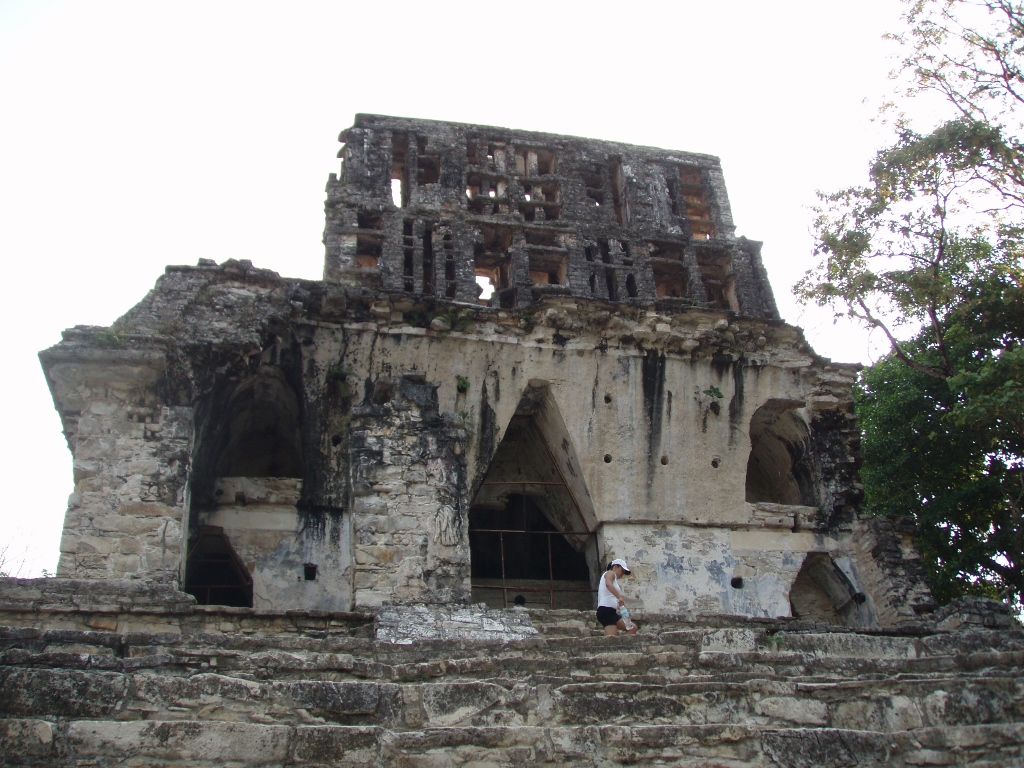 Temple of the Cross at the top of the stairway
Temple of the Cross at the top of the stairway
When I got to the top and caught my breath again, I entered the shrine of the Temple of the Cross. The ground plan of this temple is the same as in the case of the Temple of the Sun, only the front section has been demolished here. So, on the front side there are four pillars that carry the roof of the porch. In the wall behind the porch, there are three openings, all three in the shape of a corbel arch, with the central one being the biggest. Through this arch one enters a large room within which there is the central shrine in the shape of a smaller room that has its own roof.
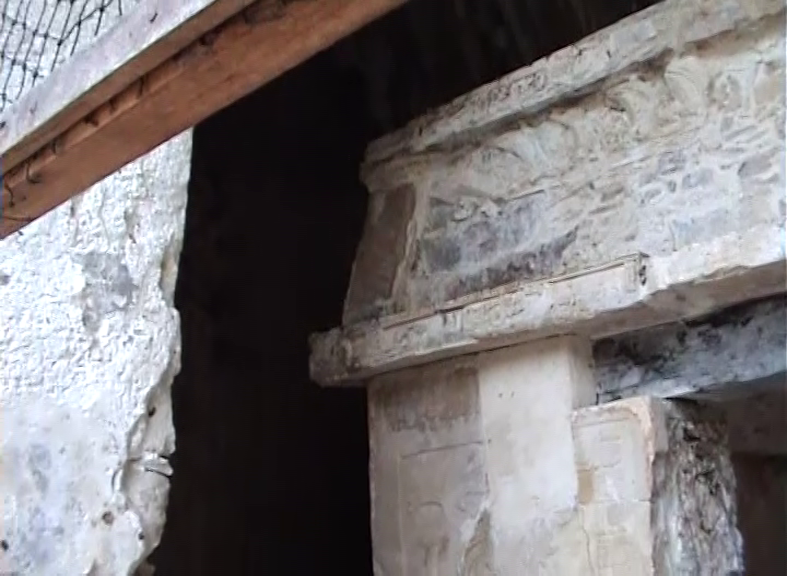 Temple of the Cross – view at the central shrine within a large room
Temple of the Cross – view at the central shrine within a large room
By the way, these three of the most important temples within the Cross Group were dedicated to three deities from a very complex pantheon of the ancient Mayas. I found everything that I’ve read on the subject very complex, as well as extremely confusing and even inconsistent, and for this reason I did not go deeper into it. The point is that on the wall to the left from the entrance into the interior shrine there is a depiction of one figure, while on the wall to the right there is a depiction of another figure and these two images are supposed to be the Mayan gods of death that come in pair.
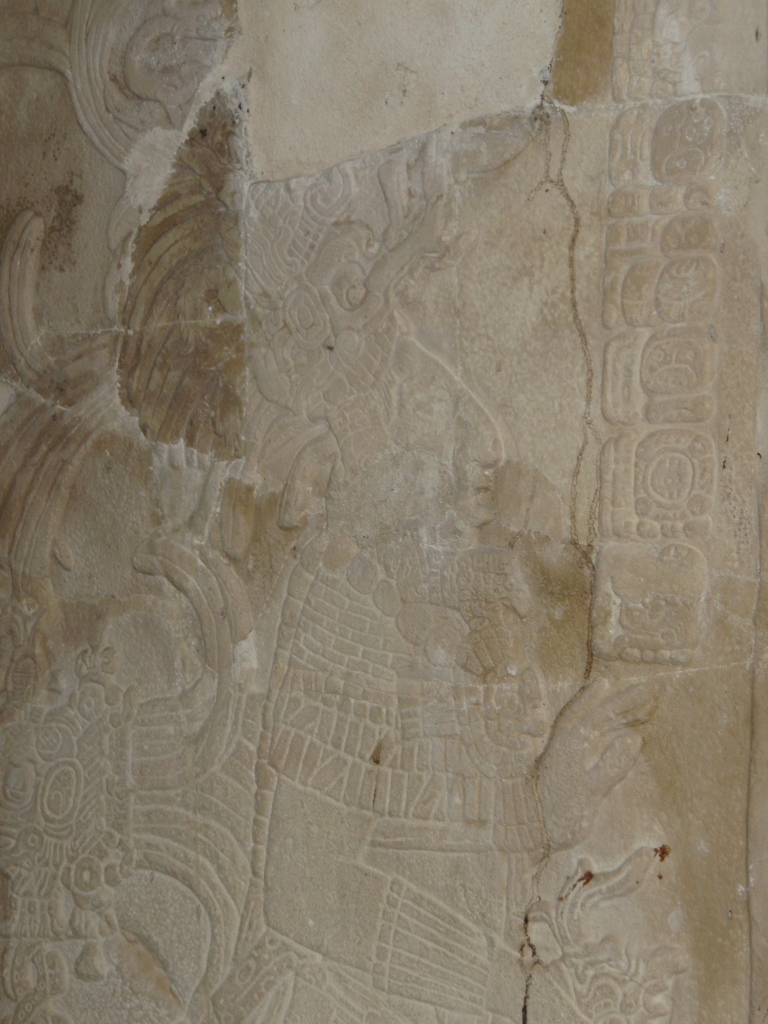 Temple of the Cross – the deity on the left-hand side
Temple of the Cross – the deity on the left-hand side
I found the image to the right from the entrance particularly interesting, since it shows a very old man who is smoking. Almost like an anti-ad: If you smoke, this is what you will look like.
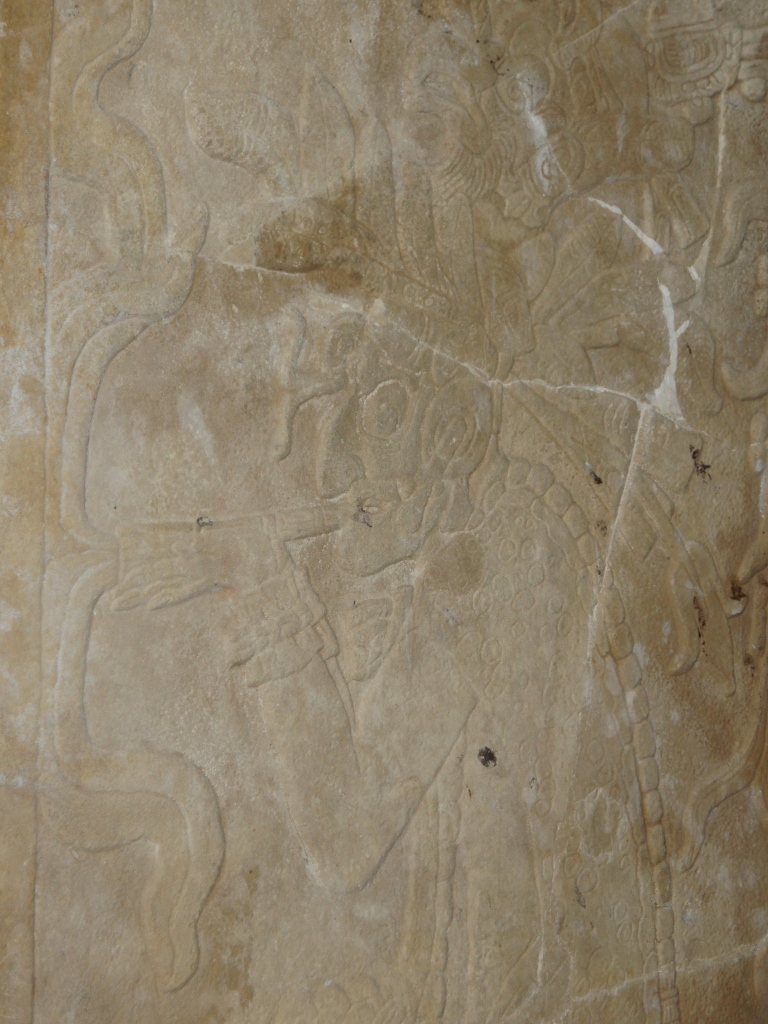 Temple of the Cross – the deity on the right-hand side
Temple of the Cross – the deity on the right-hand side
On the panel in the interior of the shrine, the most interesting for me were the numerous glyphs.
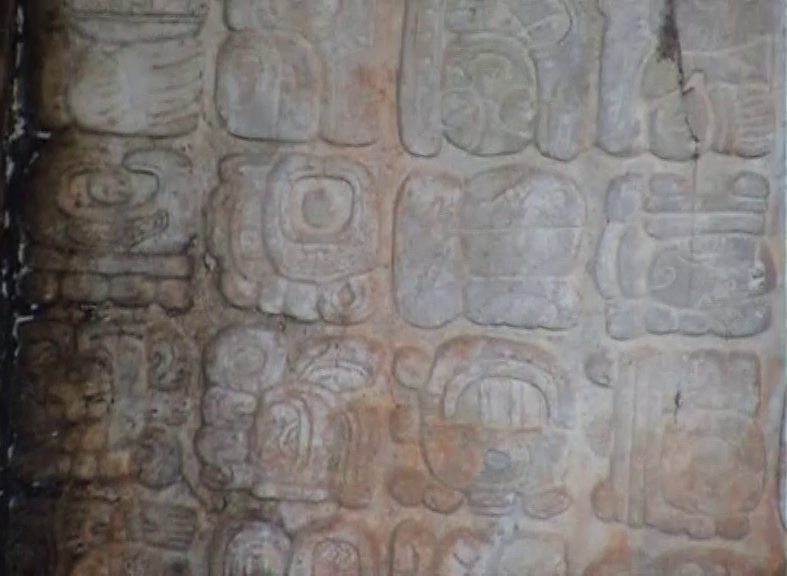 Temple of the Cross – the glyphs on the stone panel in the interior shrine
Temple of the Cross – the glyphs on the stone panel in the interior shrine
Since I’m already showing the photograph of these glyphs, that is, the ideograms, it needs to be said that in addition to carving them into stone panels or sculpting them in gypsum by using the stucco technique, the ancient Mayas also used to have several thousand of books, since they made scrolls out of the bark of some tree. However, the first Spanish missionaries were very zealous and wanting to move the local population away from the old traditions as soon as possible, they mostly burned these. Luckily, some texts did manage to survive thanks to some other zealous missionaries who were obviously also enlightened and who translated some texts or copied them along with a translation into Spanish, etc. so that the script of the ancient Mayas has been partially deciphered until the present times.
The most famous written piece of the ancient Mayas is a text that records the mythology and legends of the K’iche’ people, known under the name of Popol Vuh, and it has reached us thanks precisely to one enlightened missionary, Francisco Ximénez. The ancient Mayas used to pass their mythology and legends mostly orally, but his text was written down soon after the arrival of the Spanish in the language of the K’iche’ people and by using the Latin script. Parallel to copying this text, father Ximénez also did the translation into Spanish.
There is the same situation with another famous text, the book of prophesy Chilam Balam – a writing in the Yucatec Maya language, but with the Latin script.
However, there are some books written on those scrolls made of tree bark that are originals (only three of them!) and that have miraculously survived different types of calamities. These are the Dresden Codex, the oldest book from Americas that has survived to the present times (it is believed that it dates back to the 11th or the 12th century), as well as the Paris codex and the Madrid codex. All three of them are written in Mayan hieroglyphs and are kept in these three cities after which they have been named.
Before I left the Temple of the Cross, once again I had my photo taken at the top of the stairway from where there was a wonderful view at the Temple of the Sun...
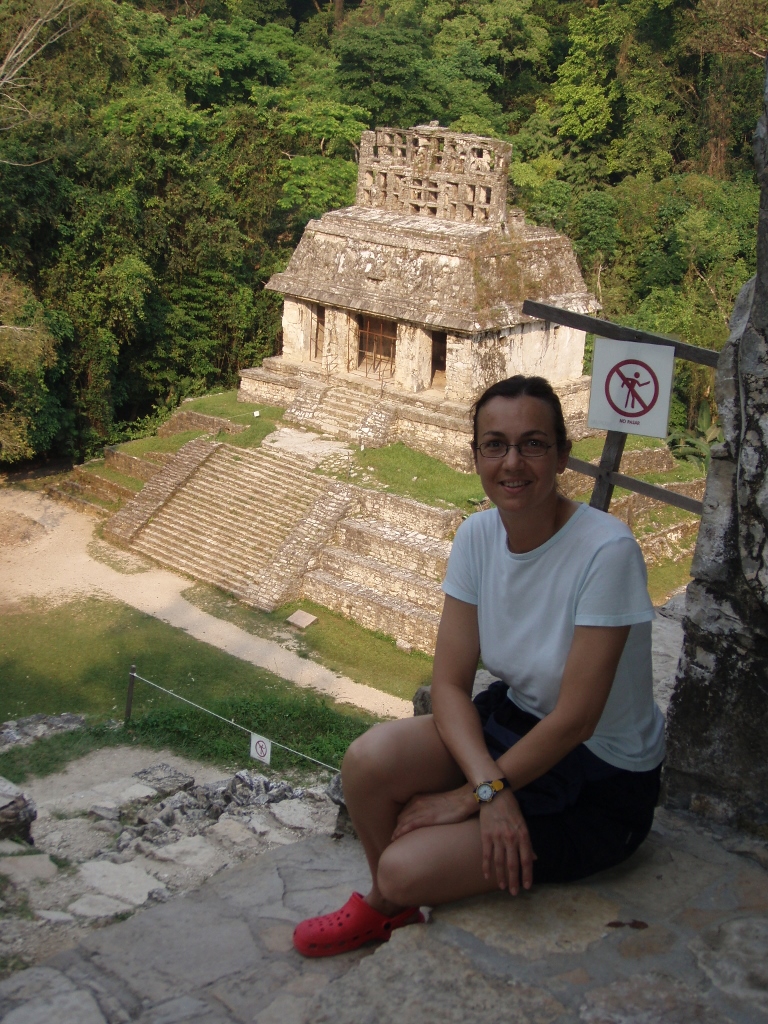 With the Temple of the Sun in the background
With the Temple of the Sun in the background
... and there was also another good view at the central part of this splendid archaeological site Palenque.
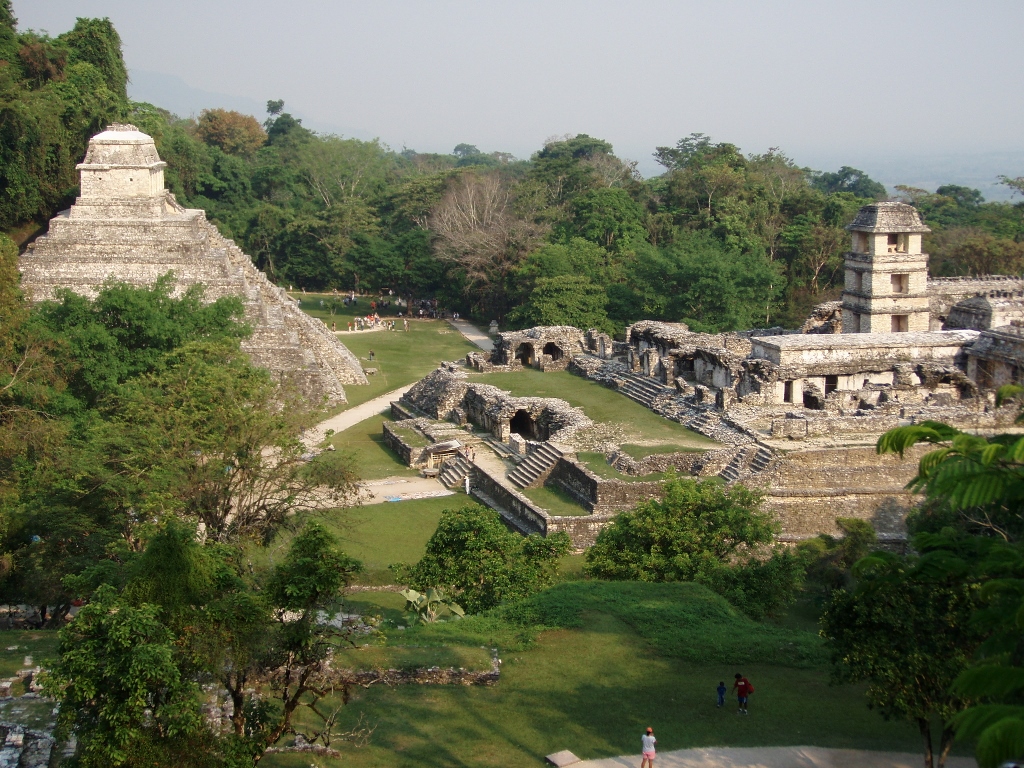 Central part of Palenque
Central part of Palenque